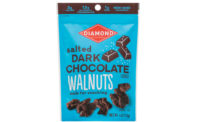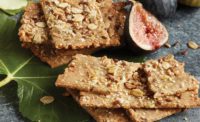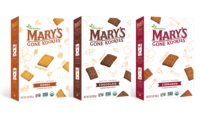Crackers stand on their own with unique nutrition and flavors










The crackers category is, without a doubt, in transition. Previously a vehicle for cheese and a garnish for soup, the humble cracker is transforming into a snack that can stand on its own in terms of nutrient profiles and flavors.

As shoppers—and brands—adjust to the new landscape, sales remain stable. According to data from IRI, Chicago, sales in the crackers category overall remained relatively flat during the 52 weeks ending September 10, 2017, dropping 0.15 percent in dollar sales to $7.4 billion.
But some products clearly stood out from the competition for the year. Nabisco’s Good Thins, from category leader Mondelēz International, saw growth of 66.19 percent to $74.6 million, and Kellogg Co.’s Sunshine Cheez It Duoz grew 71.85 percent to $54.3 million. Cheez It Grooves also gained ground, up 11.31 percent to $94.9 million.
And while the overall crackers with fillings segment was likewise flat (up 0.12 percent to $1.1 billion), Nabisco’s segment-leading Ritz sandwich crackers grew 21.16 percent to $133.3 million.
Nutrition-rich
As the crackers category undergoes a transformation, so too does the better-for-you trend that impacts it. “The better-for-you segment has evolved from a ‘food minus’ philosophy—such as reduced fat—to a ‘food plus’ approach—such as using vegetable powders, pulses, plant-based proteins, whole or ancient grains, or nut-based flours as bases,” explains Jennifer Stephens, vice president of marketing, Fiberstar, Inc., River Falls, WI.
The “food minus” trend as it pertains to sugar is still impacting crackers, though, says Jim Kappas, vice president of sales and marketing, Malt Products Corp., Saddle Brook, NJ. As such, malt extracts remain popular ingredients in this category, since they’re inherently lower in added sugars. In fact, says Kappas, “an argument can be made that they have no added sugars, since they are hydrolyzed using endogenous enzymes,” which can be a powerful labeling message for brands.
Keeping sodium low is also still a concern, says Naomi Novotny, president, SaltWorks, Inc., Woodinville, WA. But rather than purely minimizing sodium, cracker formulators may benefit from using sodium more wisely so as to get the most flavor out of a lesser amount.
“Sea salts and mineral salts like our Ancient Ocean Himalayan Pink Salt are recognized by consumers as more flavorful and healthful,” explains Novotny, and can make for powerful on-pack messaging. SaltWorks offers all-natural sea salt in a selection of grain sizes, from very fine powder grain for even coating to granulations that offer a crunchy texture and visual appeal. She notes that SaltWorks salts can help manufacturers lower salt content in their recipes—but not the salty taste.
Cracker manufacturers are also finding success by adding in ingredients with a better nutrient profile.
“Consumers are demanding more than a basic saltine for a variety of occasions,” says David Guilfoyle, group manager, bakery, fats and oils, DuPont Nutrition & Health, New Century, KS. “Consumers are looking for higher protein in their foods, and this includes crackers.” To that end, DuPont offers many protein addition options, including soy and pulse proteins, and in many different forms, from powders to nuggets and flakes. DuPont has also recently launched a new line of pea proteins, also available in powders, nuggets, flakes and other forms. “The pea proteins are very big in consumer trends and are a great way to add protein into snacks and crackers,” he adds.
But perhaps the biggest trend impacting better-for-you-crackers is the addition of whole and ancient grains.
Joni Huffman, vice president of domestic business development, Healthy Food Ingredients (HFI), Fargo, ND, notes the company is launching new varieties of bean, pea and Suntava purple corn grits to use in various applications, including crackers. “These are essentially crushed kernels that provide the heartiness of whole grains and also add visual appeal,” she explains. HFI also offers flaked ingredients, as well as milled flax and chia, which can boost a cracker’s nutrient content.
“The overall goal of almost all new product formulations is to provide clean labels while still maintaining flavor and creating an eating experience,” says Catherine Barry, director of marketing, National Honey Board, Firestone, CO. “These trends have allowed the cracker category to push the boundaries on the types of grains and alternative proteins used as the foundation of a cracker product.” She has noticed that many cracker brands are shelving white, enriched flours in favor of whole and ancient grains, which offer a better nutritional profile.
The downside? These alternative grains can carry some off flavors, which need to be offset. One option is the sweetener used in the matrix, and in an environment where added sugars are scrutinized, cracker brands would be wise to choose a sweetener that’s recognizable and clean label, says Barry. “Honey is the perfect ingredient to mask any off flavors that whole grains may carry,” she explains. “Plus, it’s a great marketing tool. Honey is the perfect all-natural sweetener to use not only in the product, but also in the product name and packaging graphics.” As a bonus, she notes the gluconic acid in honey works to elevate the popular herbs and spices used in artisan crackers, like rosemary and garlic.
Some of the alternative grains in play with crackers today are gluten-free, and formulating with these flours and alternative grains can be difficult, says Nesha Zalesny, technical sales manager, Fiberstar. First, non-grain flours don’t have the same binding and water-holding properties as wheat flour, she points out. A clean-label solution to this issue is citrus fiber. “Citri-Fi is a functional fiber that holds seven to 10 times its weight in water and can emulsify six times its weight in oil,” she says.
The result? Manufacturers can use a whole-foods approach to adding nutrients to their crackers, one that relies on the native fiber, oils and protein of the ingredients, rather than adding protein or fiber separately later. “This approach minimizes the amount of ingredients in the cracker, giving it the clean and simple look while still carrying a health halo,” Stephens says.

A flavorful future
Previously a blank slate, neutral-flavored crackers simply won’t cut it for consumers—especially millennials, who want adventurous flavors. “Snack manufacturers should look at the independent and fast-casual restaurant industry for cues on the next flavor trends, as that’s where the millennial and Gen Z generations are spending their dollars,” says Guilfoyle, “and they are looking for those flavor trends on the grocery shelf.”
Zalesny notices Southeast Asian, Indian and African cuisine as leading the way with flavors. Specifically, Burmese cuisine is on her radar, a blend of spicy Indian and Chinese flavors.
Jonas Feliciano, market research manager, Kerry, Beloit, WI, says one way cracker brands can dip their toes into the adventurous flavor trend is by kicking up classic flavors with something unexpected. For example, the well-performing Cheez It Duoz utilize classic Cheddar alongside jalapeño or bacon flavors. Kerry offers a wide dairy portfolio, including Non-GMO Project Verified and organic dairy cheese powders, as well as powders free from colors and flavors.
SaltWorks is meeting the trends with naturally cold-smoked salts like Yakima Applewood Smoked Sea Salt as well as Durango Hickory Smoked Sea Salt, in addition to its flavor-infused varieties boosted with sriracha, ghost pepper and other on-trend ingredients. “These allow cracker and snack food manufacturers to tap into these top flavor trends without having to adjust product formulations or incorporate new or additional ingredients to mask bitter flavor notes that may develop when using liquid smoke or processed ingredients,” explains Novotny.
In the end, for a category in transition, it will be about finding the balance between better-for-you and better-tasting, says Feliciano. “Moving forward, cracker manufacturers will continue to search for the right combination of natural ingredients and bold flavors.”
On-trend launches
From bolder flavors to better ingredients, new launches in 2017 were developed with an eye to trends. Here are three top trends and the new launches that accompanied them this year.
Bold Flavors
Vea
Company: Mondelēz International
Varieties: Thai Coconut, Tuscan Herbs, Peruvian Sweet Potato, Greek Hummus
Bonus: In addition to on-trend international flavors, Vea savory biscuits are made with no artificial ingredients, colors, flavors or trans fats, and they’re Non-GMO Project Verified.
Added Nutrients
Crunchmaster Protein Snack Crackers
Company: TH Foods, Inc.
Varieties: Sea Salt, Roasted Garlic, Barbeque
Bonus: Boasting whole grains and 5 grams of protein per serving, this cracker line is clearly positioned as a protein snack.
Ancient Grains
Organic Sprouted Grains
Company: Primizie Snacks
Variety: Smoked Cheddar, Rustic Beets, Ancient Grains, Green Harvest
Bonus: Made with brown rice, teff, millet, amaranth, quinoa and sorghum, these flavor-rich “flatbread crisps” offer 9 grams of whole grains per serving.

Looking for a reprint of this article?
From high-res PDFs to custom plaques, order your copy today!










